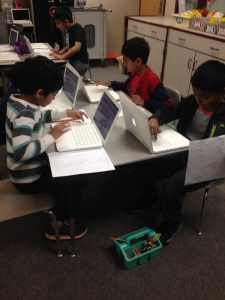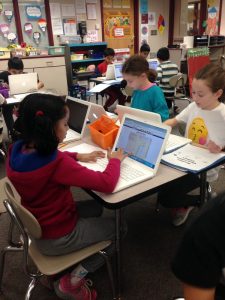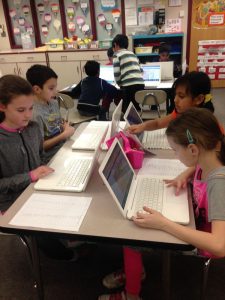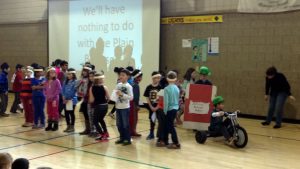Posted by kavery508 | Posted in Uncategorized | Posted on March 6, 2017
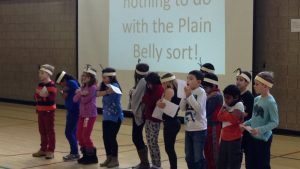 What a great time we had during Read Across America week! Our class and the Richards class presented a reader’s theatre version of Dr. Seuss’ The Sneetches to grades 1 and 2 at our School Meeting. The kids did an awesome job acting their parts and reading with expression, and they engaged the audience who read along with us.
What a great time we had during Read Across America week! Our class and the Richards class presented a reader’s theatre version of Dr. Seuss’ The Sneetches to grades 1 and 2 at our School Meeting. The kids did an awesome job acting their parts and reading with expression, and they engaged the audience who read along with us.
We also kicked off a community-wide literacy project as a way to promote reading to a wide audience! Students at our school will be making bookmarks that will be handed out to all children when they borrow books at the Shrewsbury Public Library. Kids are then asked to take a picture of themselves reading, and post it on social media using the hashtags #readtosucceed and #shrewsburylearns. We’re hoping to go viral!
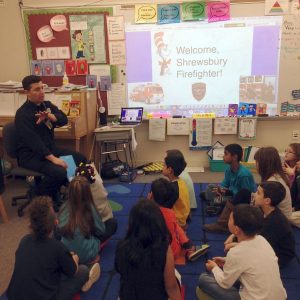 On Friday, we were treated to a visit from Shrewsbury’s own Firefighter Vincequere. Mr. Vincequere read aloud And to Think That I saw it On Mulberry St, and shared with students the impactful ways reading affects his personal and professional life. A big thanks to him for being a great model for our kids!
On Friday, we were treated to a visit from Shrewsbury’s own Firefighter Vincequere. Mr. Vincequere read aloud And to Think That I saw it On Mulberry St, and shared with students the impactful ways reading affects his personal and professional life. A big thanks to him for being a great model for our kids!
 We are still in need of boxes of Kleenex to get us through the rest of winter and through the spring. Please send in a couple of boxes if you haven’t, and thanks!
We are still in need of boxes of Kleenex to get us through the rest of winter and through the spring. Please send in a couple of boxes if you haven’t, and thanks!
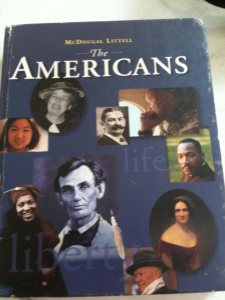 This week, students continue to use a variety of print and visual sources to research a famous American and the traits that made them stand out. Here are two great examples from 1. Naomi on Susan B. Anthony, and 2. Elaine on Sally Ride: 1. Susan was hardworking. Susan and Elizabeth gave speeches, held meetings, and wrote books and articles. They wanted to bring attention to women suffrage. Susan worked for women’s rights her whole life. 2. Sally was intelligent. She got good grades. She went to college, and then she got her doctorate! Awesome!
This week, students continue to use a variety of print and visual sources to research a famous American and the traits that made them stand out. Here are two great examples from 1. Naomi on Susan B. Anthony, and 2. Elaine on Sally Ride: 1. Susan was hardworking. Susan and Elizabeth gave speeches, held meetings, and wrote books and articles. They wanted to bring attention to women suffrage. Susan worked for women’s rights her whole life. 2. Sally was intelligent. She got good grades. She went to college, and then she got her doctorate! Awesome!
 Our work with money wraps up by challenging students to solve real world problems involving computation and reasoning. Consider this problem from their workbooks: Devon spends 2 dimes at the store. Then he spends 3 nickels more. If he pays with $1.00, how much change should he get? Notice how it requires that students apply their understanding of money amounts and thinking skills in order to calculate change? Here is an awesome online game that helps kids practice these useful skills:
Our work with money wraps up by challenging students to solve real world problems involving computation and reasoning. Consider this problem from their workbooks: Devon spends 2 dimes at the store. Then he spends 3 nickels more. If he pays with $1.00, how much change should he get? Notice how it requires that students apply their understanding of money amounts and thinking skills in order to calculate change? Here is an awesome online game that helps kids practice these useful skills:
And last this week:

What an amazing job students have done in science! After collecting temperature data from the past month that is valid and reliable, they organized it in tables and created bar graphs (try it yourself with any data you like–it’s really cool! http://nces.ed.gov/nceskids/createagraph/). This week they will analyze the data to look for trends and anomalies; aggregate the data to answer specific questions; and draw conclusions about temperature in winter, 2017. Wow!


